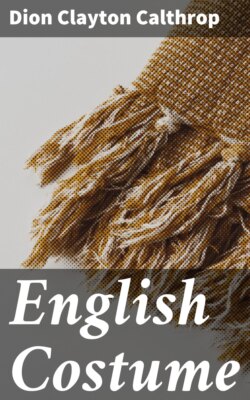Читать книгу English Costume - Dion Clayton Calthrop - Страница 22
На сайте Литреса книга снята с продажи.
THE WOMEN
ОглавлениеTable of Contents
About this time came the fashion of the chin-band, and again the glory of the hair was hidden under the wimple.
To dress a lady’s hair for this time the hair must be brushed out, and then divided into two parts: these are to be plaited, and then brought round the crown of the head and fastened in front above the forehead. The front pieces of hair are to be neatly pushed back from the forehead, to show a high brow. Now a cloth of linen is taken, folded under the chin, and brought over the top of the head, and there pinned. Then another thin band of linen is placed round the head and fastened neatly at the back; and over all a piece of fine linen is draped, and so arranged that it shall just cover the forehead-band and fall on to the shoulders. This last piece of linen is fastened to the chin-band and the forehead-strap by pins.
This fashion gave rise in later times to a linen cap; the forehead-strap was increased in height and stiffened so that it rose slightly above the crown of the head, and the wimple, instead of hanging over it, was sewn down inside it, and fell over the top of the cap. Later the cap was sewn in pleats.
The gown of this time was quite loose, with a deep band round the neck and round the hem of the skirts, which were very full. So far as one can tell, it was put on over the head, having no other opening but at the neck, and was held at the waist by an ornamental girdle.
The chemise showed above the neck of the gown, which was fastened by the usual round brooch.
A WOMAN OF THE TIME OF HENRY II. (1154-1189)
There is a chin-band to be seen passing under the wimple; this band is pinned to hold it round the head.
The sleeves were well fitting, rather loose at the elbow, and fell shaped over the wrist, where there was a deep border of embroidery. It is quite possible that the cuffs and hem may have been made of fur.
The shoes were, as usual to the last two reigns, rather blunt at the toe, and generally fitting without buckle, button, or strap round the ankle, where they were rolled back.
Above the waist the tied girdle was still worn, but this was being supplanted by a broad belt of silk or ornamented leather, which fastened by means of a buckle. The tongue of the belt was made very long, and when buckled hung down below the knee.
The cloaks, from the light way in which they are held, appear to have been made of silk or some such fine material as fine cloth. They are held on to the shoulders by a running band of stuff or a silk cord, the ends of which pass through two fasteners sewn on to the cloak, and these are knotted or have some projecting ornament which prevents the cord from slipping out of the fastener.
In this way one sees the cloak hanging from the shoulders behind, and the cord stretched tight across the breast, or the cord knotted in a second place, and so bringing the cloak more over the shoulders.
The effigy of the Queen at Fontevraud shows her dress covered with diagonal bars of gold, in the triangles of which there are gold crescents placed from point to point, and no doubt other ladies of her time had their emblems or badges embroidered into their gowns.
